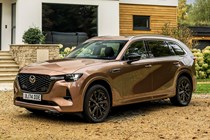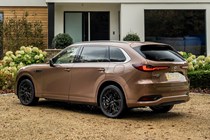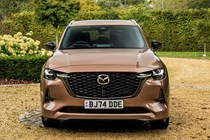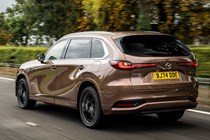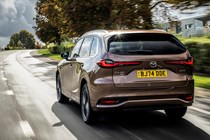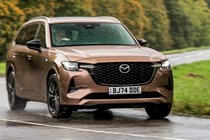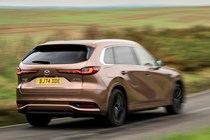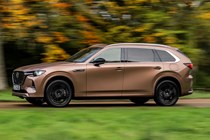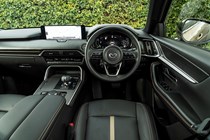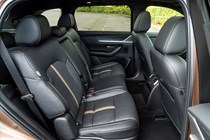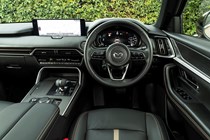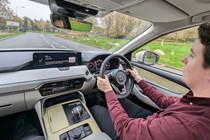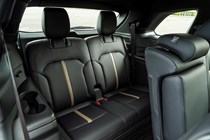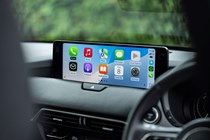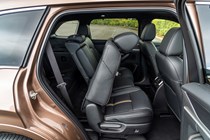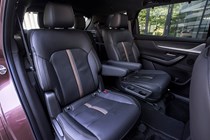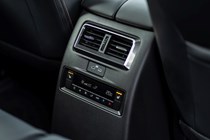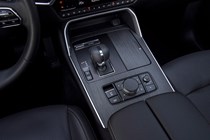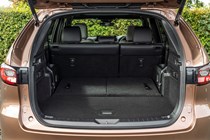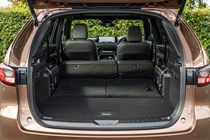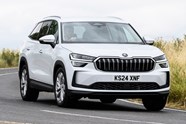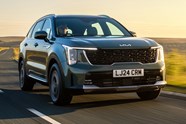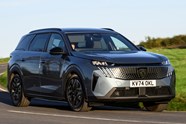
Mazda CX-80 review
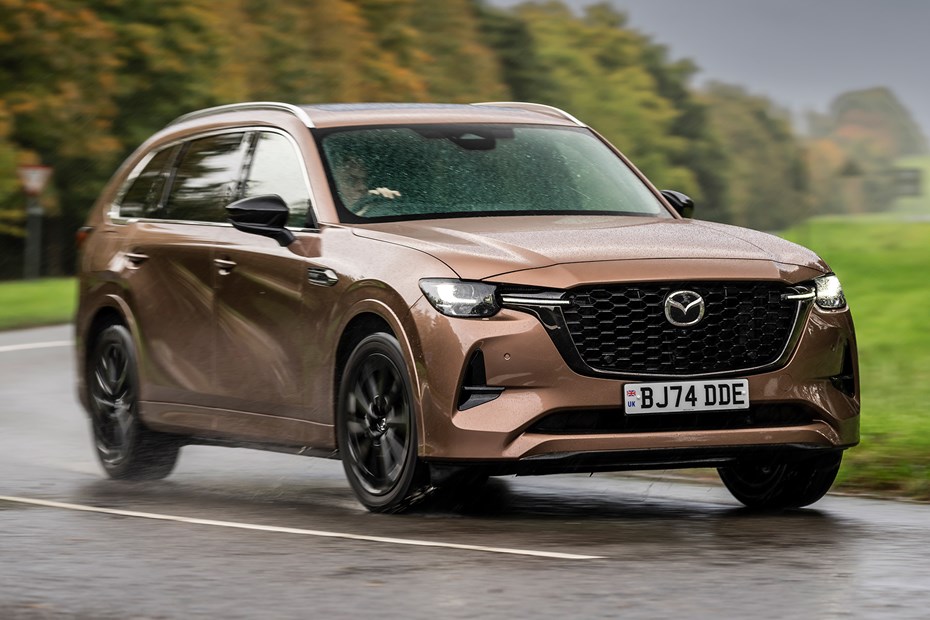
At a glance
| Price new | £49,780 - £60,595 |
|---|---|
| Used prices | £34,388 - £48,950 |
| Road tax cost | £620 |
| Insurance group | 37 - 39 |
Get an insurance quote with

|
|
| Fuel economy | 48.7 - 49.6 mpg |
| Miles per pound | 6.2 - 6.3 |
| Number of doors | 5 |
| View full specs for a specific version | |
Available fuel types
Diesel
Hybrid
Pros & cons
- Spacious and flexible interior
- High-quality and easy-to-use interior
- Lots of equipment is included as standard
- Unrefined plug-in hybrid
- Still not as comfortable as a Skoda Kodiaq
- Boot not as useful as rivals'
Mazda CX-80 SUV rivals
Overview
Mazda has had most of the family SUV market covered off for a while, but until last year a big seven-seater was absent from the range. That all changed with the introduction of the CX-80 – Mazda’s new de-facto flagship SUV model with the most interior space of any in the lineup and the capacity to carry seven in comfort.
The CX-80 might look familiar, and that’s because it’s based on the CX-60 SUV. That car was introduced in 2022 to take the company more upmarket and challenge cars such as the BMW X3 and Audi Q5. Both the CX-60 and 80 use Mazda’s ‘large car’ platform that underpins even bigger SUVs sold elsewhere in the world. This one is essentially the front half of a 60, and incorporating a stretched wheelbase to squeeze in a third row of seats.
At just shy of five metres, this new Mazda is a big SUV and larger than many of its rivals – the Skoda Kodiaq, Hyundai Santa Fe and Kia Sorento are slightly smaller in terms of outright dimensions. It’s even longer than a Land Rover Discovery. A large part of its length is, however, taken up by a huge bonnet, which is needed to accommodate its quite significantly-sized engines. The first is a 2.5-litre plug-in hybrid and the second a 3.3-litre straight-six diesel engine. The latter is quite a rarity these days when many of its rivals are now only available as some sort of hybrid.
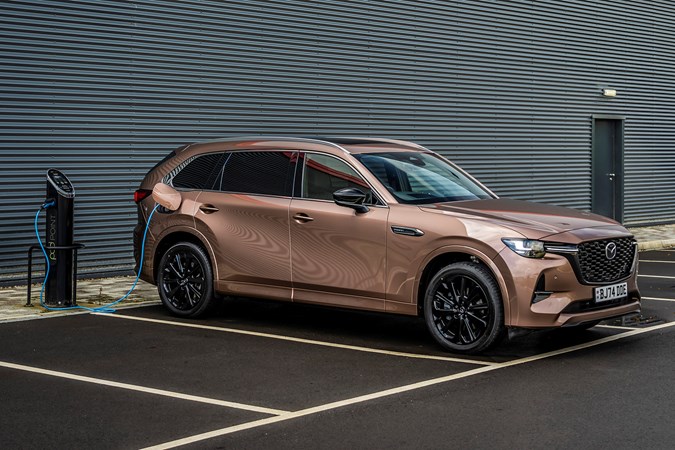
Available in a wide range of trim levels, it’s more expensive than a CX-60, and puts it in the middle ground between cheaper seven-seaters, such as a Skoda Kodiaq, and far more expensive premium rivals like the Audi Q7.
We’ve never been hugely impressed by the CX-60, owing to its unsettled ride and unrefined hybrid setup, so have been keen to see if the new CX-80 can improve on things. Following our drives at the international launch in Europe and on UK roads, read on to find out if it’s been a success, and then discover more about how we test cars at Parkers by going to the dedicated explainer page.
What’s it like inside?
If you aren’t a fan of your car’s interior being laden with big touchscreens and having next to no physical buttons, you’ll probably like the Mazda CX-80. Mazda isn’t afraid of doing things differently, and this SUV bucks the trend by having a stylish dashtop-mounted sliimline infotainment screen controlled by a useful rotary dial – similar to BMW’s iDrive controller.
Using a physical controller makes the screen much easier to operate on the move and less distracting too, while we like having the CX-80’s physical buttons to change the climate settings, rather than being reliant on a touchscreen. It’s a particularly well-laid-out interior with excellent ergonomics, the only exception being the slightly awkward gear selector.

All models also come with electric leather seats as standard, helping to give the CX-80 a more upmarket feel, as many rivals only come with these features in higher-specs. Quite plain black leather upholstery is on the standard trim, with the mid-spec Homura getting upgraded Nappa leather with copper accents.
The range-topping Takumi features white leather seats and white maple trim. We’re not a fan of having such a light-coloured interior in a family car and can’t see it ageing all that well. You can’t knock the CX-80 for its interior quality, with all elements having a solid and well-finished feel. There are plenty of soft-touch materials used throughout the upper portion of the interior, but some cheap-feeling plastics from the glovebox down. Some might reckon it’s a bit traditional, but in this instance, we think it’s for the best.
Practicality
If you’re looking for a seven-seat SUV, spaciousness is a top priority, and the CX-80 doesn’t disappoint. Mazda has put those large dimensions to good use, with a flexible and practical interior. The smaller CX-60 always felt a bit of a pointless product as, despite being much larger and more expensive than a Mazda CX-5, it didn’t really offer that much more space inside.
Unlike rivals such as the Skoda Kodiaq, the CX-80 comes with seven seats as standard – and on the plug-in hybrid too – though higher-spec Homura and Takumi are available in a six-seat configuration that sees the second-row bench of seats replaced by two individual captain’s chairs. While it undoubtedly makes the cabin feel more luxurious with six seats, we think having the full seven seats is more of an advantage.
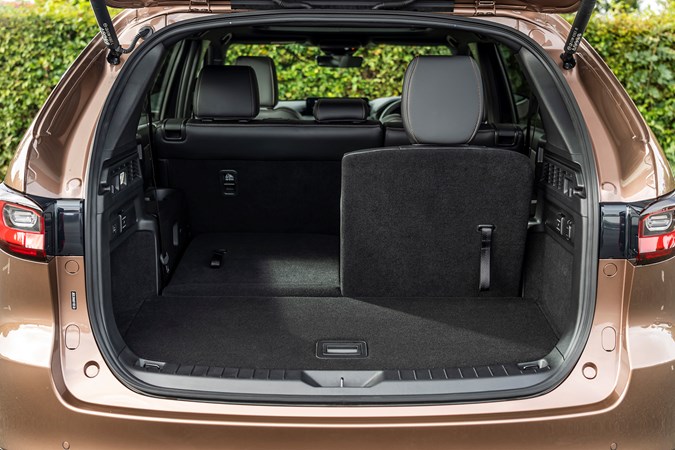
Access to the third row is surprisingly easy, too, with the middle row seats sliding a long way forward. While it’s not a car we’d choose to use for transporting seven adults, it’s suitable for such use for short distances, as one of our testers at just shy of six feet tall could sit in the third row without too much of a squash, but they’re best saved for small passengers. There are USB-C sockets in the third row too, along with plenty of storage. Middle-seat space is also plentiful, though the panoramic sunroof’s sunblind does eat into available headroom if you have it closed.
While the boot is large, it’s not as roomy as some rivals’, with quite a high boot floor meaning it’s not as wide or deep as that of a Skoda Kodiaq. With all rows of seats in position it offers 258 litres, followed by 687 litres with five seats and 1,971 litres if you want a van-like cargo area with only the front two seats still upright. An electric boot is standard but it doesn’t open up very far, which means taller adults might find themselves accidentally hitting their heads on the boot.
Diesel engine and plug-in hybrid
Powertrains on the Mazda CX-80 include a straight-six 3.3-litre diesel and a plug-in hybrid – the latter being detailed below. Each features an eight-speed automatic transmission and comes with all-wheel-drive as standard.
The diesel engine was first used in the CX-60 and, while most manufacturers have downsized their engines in recent years, Mazda says this larger capacity diesel enables it to run at a higher thermal efficiency, meaning it uses less fuel. This version certainly impressed in our six-month extended review – especially as a tow car.
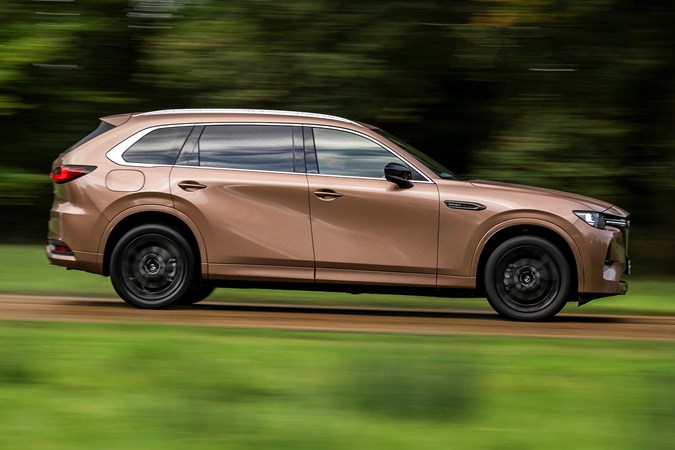
The engine develops 254hp and 550Nm of torque (pulling power), with an integrated mild-hybrid system that allows the engine to turn off when it’s coasting to maximise fuel economy. Mazda claims just shy of 50mpg and 150g/km CO2 emissions. In terms of performance, it can accelerate from 0-62mph in 8.4 seconds and hit a 136mph top speed.
Most CX-80s sold in the UK will be the plug-in hybrid (PHEV), not least because of the tax savings for company car drivers and because it costs less to buy outright than the diesel.
It pairs a 2.5-litre turbocharged petrol engine with an electric motor for a combined 327hp and 500Nm of torque, with a 0-62mph time of 6.8 seconds possible. It also packs a 17.8kWh battery, which Mazda says allows for a 36-mile electric driving range. Our test car certainly looked capable of meeting this on a run on UK B-roads, although we’ll be testing this more thoroughly at a later date.
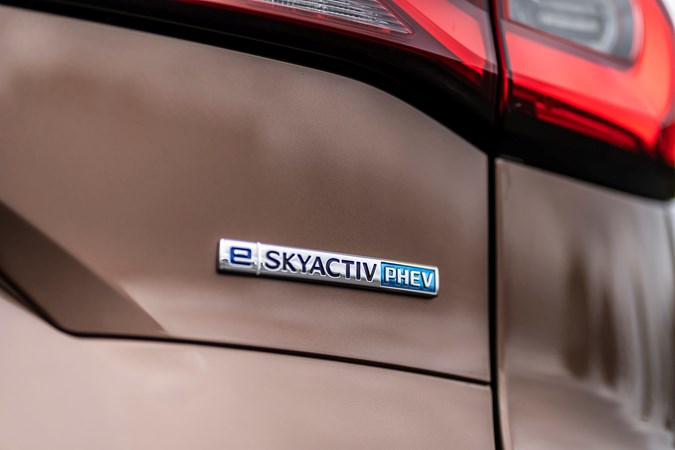
While the electric range is similar to that of a Kia Sorento and new Hyundai Santa Fe, it lags behind the impressive new Skoda Kodiaq plug-in hybrid, which averaged 63 electric miles on a charge during our testing – a remarkable figure for a large hybrid SUV. However a Kodiaq PHEV is only available with five seats and not seven like the petrol and diesel versions.
Unless you can complete most of your miles on the CX-80’s electric range, we think the diesel model could prove to be the more efficient buy overall, and certainly the better tow car.
What’s it like to drive?
There’s a big difference in the way the CX-80 drives depending on which engine you go for. The diesel is by far the most pleasant, with lots of low-down torque enabling a smooth getaway, and though it’s a bit more coarse-sounding than a six-cylinder engine in a BMW, for example, it suits this Mazda well, and is particularly refined and settled at speed.
In comparison, the plug-in hybrid is not the best. Throttle response is quite slow unless you have the CX-80 in its ‘sport’ mode (where it will consume more fuel), and it’s generally quite unrefined with some unusual noises made on occasion. It was exactly the same in the last CX-60 we tried, and it doesn’t appear that Mazda has fixed it.
Elsewhere, though, the CX-80 drives well. The ride quality is improved over the unsettled CX-60, owing to its longer wheelbase that’s better at absorbing bumps and the retuned suspension setup specifically for this seven-seater. Although it’s considerably improved over its smaller brother, it still lacks the supple and cushioning ride that you find in the Skoda Kodiaq.

That said, the steering of the CX-80 has a surprising amount of weight and responsiveness to it for a car of this size, allowing a bit more enjoyment than you would usually get from a seven-seat SUV. We particularly like the sporty way it turns into corners, and the general feeling of agility – a genuine surprise if you’re expecting something big and unwieldy.
If you push it hard, there’s some body roll, though, but this isn’t a class of car designed to be hurried along, and a firmer ride would not suit a big family SUV. For a car of these dimensions (it’s only 5cm shorter than a full-size Range Rover), it’s quite easy to place and park, with a good turning circle and excellent visibility meaning it’s not as hard to manoeuvre as you might expect.
What models and trims are available?
The CX-80 is available with a wide range of trim levels, with the plug-in hybrid actually working out cheaper than the diesel. Standard equipment is very generous, with the entry-level Exclusive Line model shipping with heated leather seats, an electric release boot, keyless entry, and a head-up display.
It also comes with a range of driver assistance technology such as blind spot monitoring and vehicle exit monitor that aims to stop you opening the door into passing traffic. This entry trim is expected to be the most popular, and we can’t say we’re surprised considering how many features you get included.
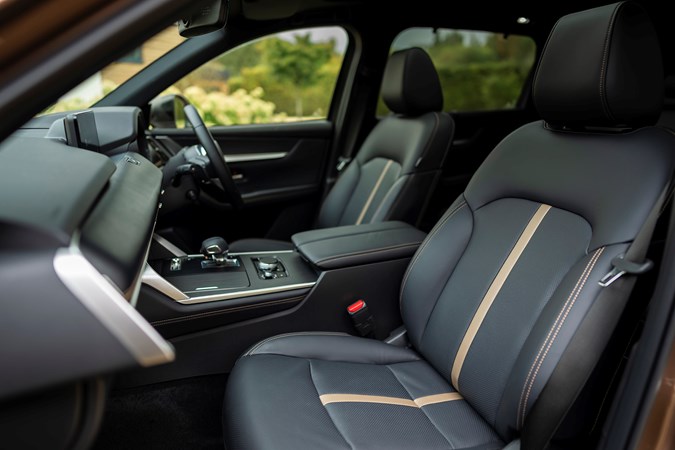
The Homura grade adds 20-inch black alloy wheels and painted wheelarch trims, along with electric front seats and a Bose sound system. Homura Plus then brings a 360-degree camera, panoramic sunroof and adaptive LED headlights.
The Takumi heads up the range, with more high-end features such as its machined 20-inch alloy wheels, white Nappa leather seats and white wood trim. The Takumi Plus grade then adds all of the extra features of the Homura Plus model.
What else should I know?
The CX-80 is the largest car Mazda has ever sold in Europe and therefore is the most expensive. Mazda is predicting quite modest sales figures as a result, though there is potential for it to sell much better.
We wouldn’t normally talk about paint colours in a Parkers review, but we admire Mazda for offering a range of cool shades on the CX-80, which is quite rare for a car in this class. Mazda’s stunning Soul Red Crystal is available, as are two new colours, Melting Copper (pictured) and Artisan Red.
The CX-80 comes out punching as a genuinely interesting seven-seater that’s good to drive and with a particularly nice interior. But is that enough to see off its established rivals? Our verdict can be found on the next page.



